Amaseia (now Amasya) lies in Turkey's Amasya province, on the Yeşil River. The folktales that we have from this region come primarily from Ano Amaseia, which lay above the main town. The ancient Amaseia goes back to Hellenistic times and was where Strabo was born. It sits at a high altitude and possesses a dry climate with hot summers and cold winters. It is considered the best apple-growing province in Turkey.
Points of Interest
Under Revision!
We'll be showing off our new look and content soon.
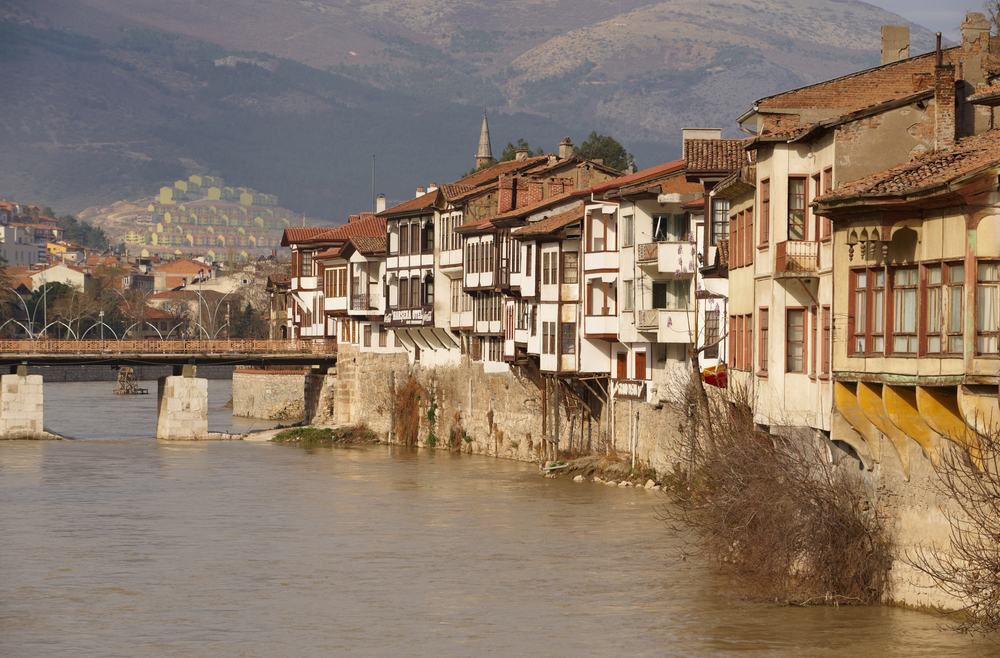
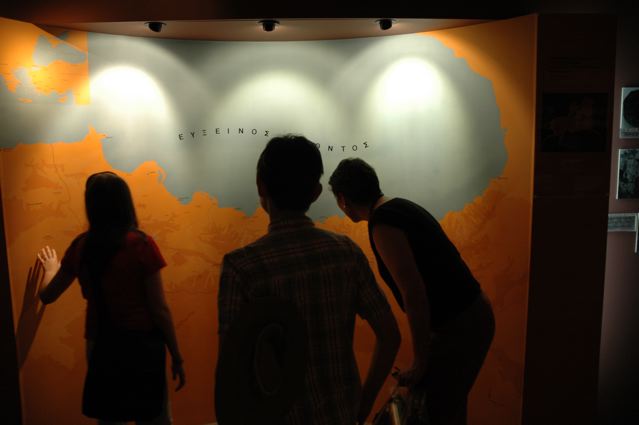
The Committee for Pontic Studies at its founding in 1924 consisted largely of clerics and teachers active in petitioning for an independent Pontic republic, men who had been educated at the major Greek schools of Asia Minor--Halki, the Megali tou Genous Skholi, and the Frontisterion of Trebizond--and who had taken as their goal the preservation and publication of their historical, linguistic, and folkloric heritage. It soon began a publishing program. The early years of the Arheion Pontou (Archive of Pontos) were devoted to preserving as much material as possible about the Pontos and its people. It contains collections of folktales, folksongs, dialectal vocabulary lists, collections of riddles, proverbs, superstitions, folk medicine beliefs, and descriptions of towns and villages and their peoples. By the late 1950s the emphasis has shifted to art history and other material history, with some folklore included. By the 1980s the trend became increasingly towards the history of what used to be regarded as “footnotes”, a crisis in the Metropoly of Trebizond in the 1870s, for example, or a biography of the founders of the monastery Panayia Soumela, or examinations of folklore texts rather than the texts themselves.
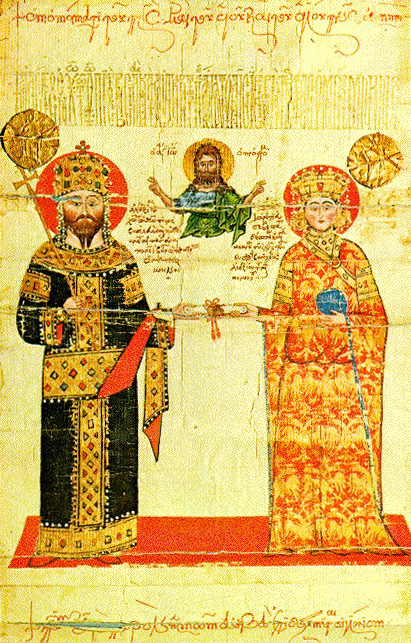
The Empire of Trebizond was was one of three Greek successor states of the Byzantine Empire. It was founded April 1204, not long before the capture of Constantinople by westeners during the Fourth Crusade, and was conquered by the Ottomans in 1461. It covered much of the southern coast of the Black Sea and the Pontic Greeks consider themselves the heirs to that empire. It was ruled by the Comnenes, a branch of the Byzantine royal family. This Chrysobull was fromm Alexios III Megas Komnenos, who lived from 1338 to 1390.
A Golden Bull or chrysobull was a golden ornament representing a seal attached to a decree issued by Byzantine Emperors. The practice was later adopted by other monarchs in Byzantine spin-off states and in Europe. This one shows Alexios and his wife, Theodora Kantakouzene, and was attached to a chrysobull granted to Dionysiou Monastery.
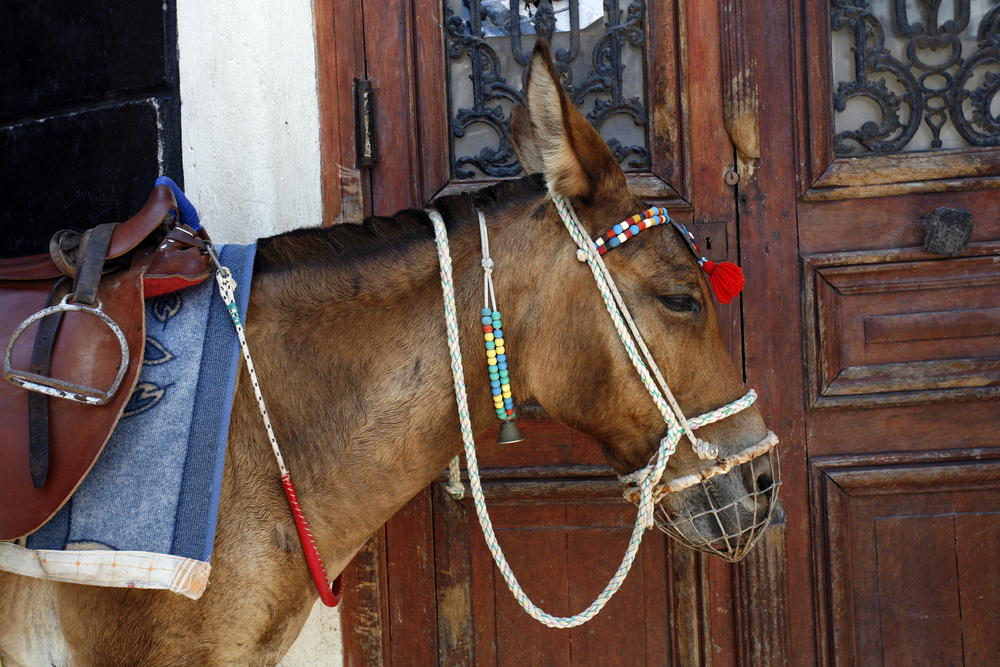
Donkeys show up throughout Pontic folktales, just as they did throughout the Pontos when the narrators of these Greek tales lived there. They play roles in “Kyrlovits,” “The Bad Aunt,” “The Nereids,” “The Three Friends,” “The Rooster and His Friends,” and, of course, “The Donkey and His Friends” and “The Donkey.” I've borrowed this one from Santorini: when I find one from the Pontos, I will be replacing it.
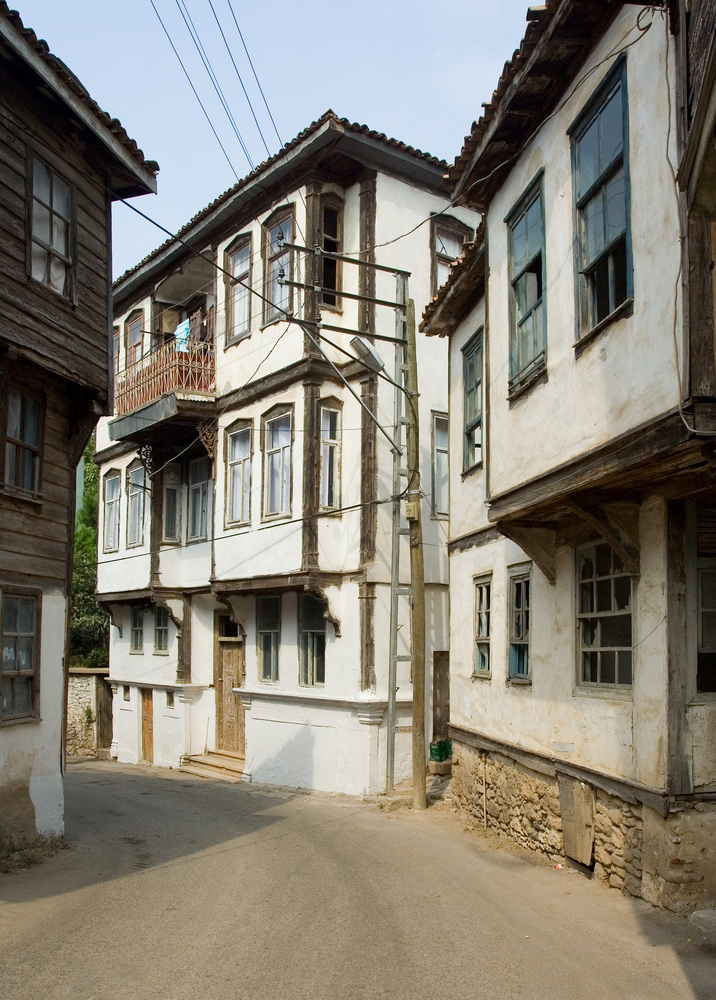
Sinope was the first Greek colony in the Pontic region. Greeks from Miletus settled there in the 7th century BC, and used it as a base from which to colonize other areas along the coast. Sinope gained importance as a port city for a caravan route leading from the upper Euphrates valley. It issued its own coinage and gave its name to a red arsenic sulfate called "Sinopic red earth." It is also famous as the birthplace of the 4th-century BC Cynic philosopher Diogenes. Because of Diogenes's stunts, such as carrying a lamp in the daytime while claiming to be looking for an honest man, it is tempting--but probably not accurate--to think of him as the original for the folktale father who is looking for a just godfather for his son (the personification of Death is the only one who satisfies his criteria).
The Frontisterion of Trapezounta was was a Greek educational institution that operated from 1682 to 1921. It provided a major impetus for the rapid expansion of Greek education throughout the Pontos. The school was moved to a three-story building with 36 classrooms in Trebizond in 1902. Although classes stopped being given to Greek students in it in 1921, during the Greek-Turkish War of 1919-1922 and just before the Exchange of Populations between Greece and Turkey, the building stands.
Founded by Sevastos Kyminitis, it was originally housed at Panagia Soumela Monastery, and it grew into the most influential center of Greek education in the region, and had the goal of cultivating national and religious identity of the local ethnic Greeks. The school was supported by generous donations granted by wealthy Greek families, including the Velissarides and Kallivazis families, who controlled trade in most of the Black Sea ports.
One of the teachers of the Frontesterion, Periklis Triantafyllidis, whose father Savvas had also taught there, taught classical philosophy and also recorded the local Greek dialect. It is to him that we can credit the earliest transcriptions of Pontic folktales.
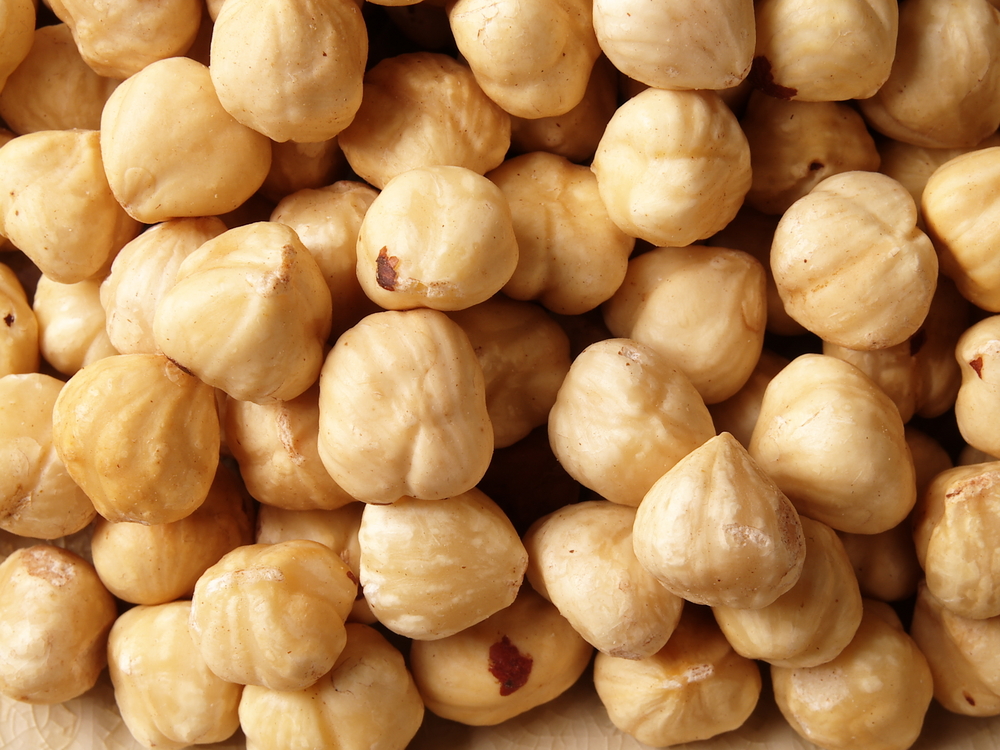
Hazelnuts were an important crop for Pontian farmers and commodity for merchants. For folktale narrators, too, they played an important role. In the past, it was common for folktales to be told at community work session. Whereas in Hungary they may have been told while working fields of sugar beets, in Germany while harvesting potatoes or working in a sand pit, or among the Lepchas while weeding crops, a prime time for the Pontians to tell tales was during the communal shucking of the corn harvest and the husking of the hazelnut crop. At the winter's evening gatherings where tales were also told, before the folktale would begin, the housewife or the daughter of the house took care to bring close to the hearth or to the brazier all the makings for coffee, so as not to be forced in the middle to get up and interrupt the continuity of the narrative. She would also bring whatever else she intended to offer to those gathered: hazelnuts usually, apples and appetizers generally, because some folktales lasted a long time. Hazelnuts are mentioned specifically in the tales of "Chortanikas," "The Son of the Widow," and at least one variant of "Cinderella."
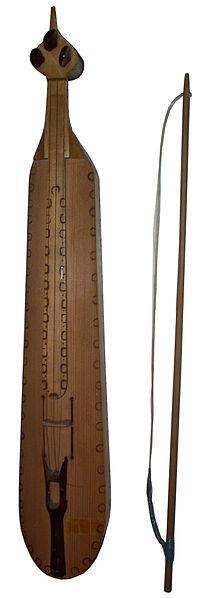
The kemenjes is the Pontic Greek lyra, also used by the other ethnic groups of the region. It is the instrument that most symbolizes Pontic Greek ethnicity, although they also play a number of others. In the theater, although virtually every performance ends in lyra-playing and dancing, the shepherd's flute occurs more often in the plays. Oddly enough, the kemenjes makes little if any appearance in the folktales. See also http://en.wikipedia.org/wiki/Kemencheso .
Like many Pontic Greeks, Filon Ktenides felt that the kementjes best expressed the full range of emotions stemming from the refugee experience. From his "Hymn to the Lyra":
I draw my bow to the right, and wounds re-open,
I draw it to the left, and send mothers into tears.
When my soul is in pain, it lives within it, and when my heart aches
I take you with me and wash my wound in tears.
The rich man has his riches, and I have you,
In all my sorrows, in my joys, you are everything I need.
When we are born and everyone rejoices, you celebrate with us,
And as we grow old and pass from this world, you comfort us.
To hear the kemenjes, go here: http://www.scimitarmusic.com/pontos/audio.html
To see a kemenjes-player interacting with dancers in an early film, go here: http://www.youtube.com/watch?v=7h6uf7o-LBk
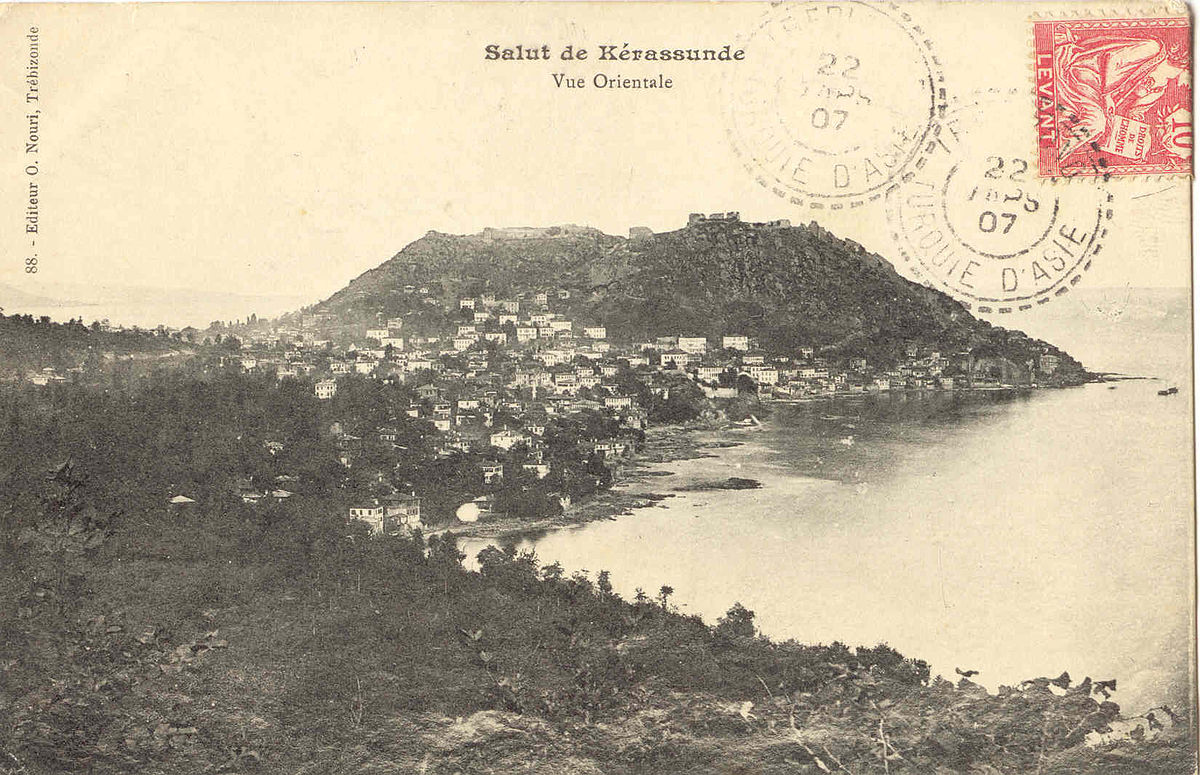
Some believe that the name "Kerasous," the pre-Turkish name of the town Giresun, is related to the Greek word κερασός "cherry". Others suggest convincingly that it was named for the horn-shaped peninsula on which it lies: κέρας "horn" (they note a similarity with the Golden Horn waterway in Istanbul, also known as Κέρας). Most Kerasuntine folktales were recorded in the 1880s and contain characters who strongly resistent to formal authority.
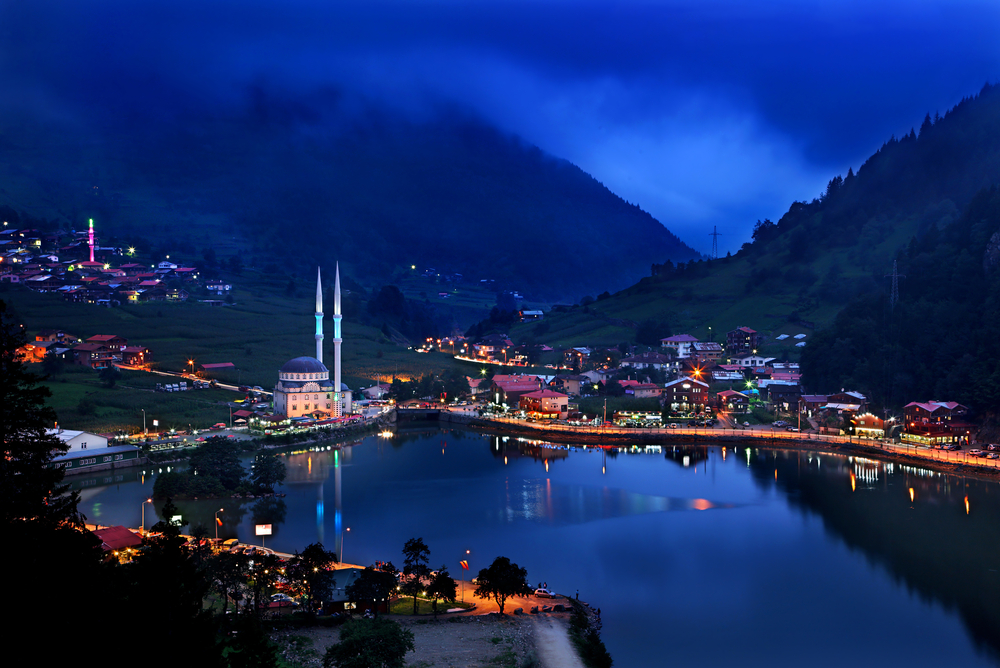
Pontic Greek residents of the upland villages, which were usually isolated by the rugged terrain, tended to base their economies on agriculture and mining, and were less stratified socially than their seaside cities were. Until around 1915, each kind of locale usually had two or more ethnicities living side by side: Greeks, Turks, Armenians, Jews, Laz, and so forth.
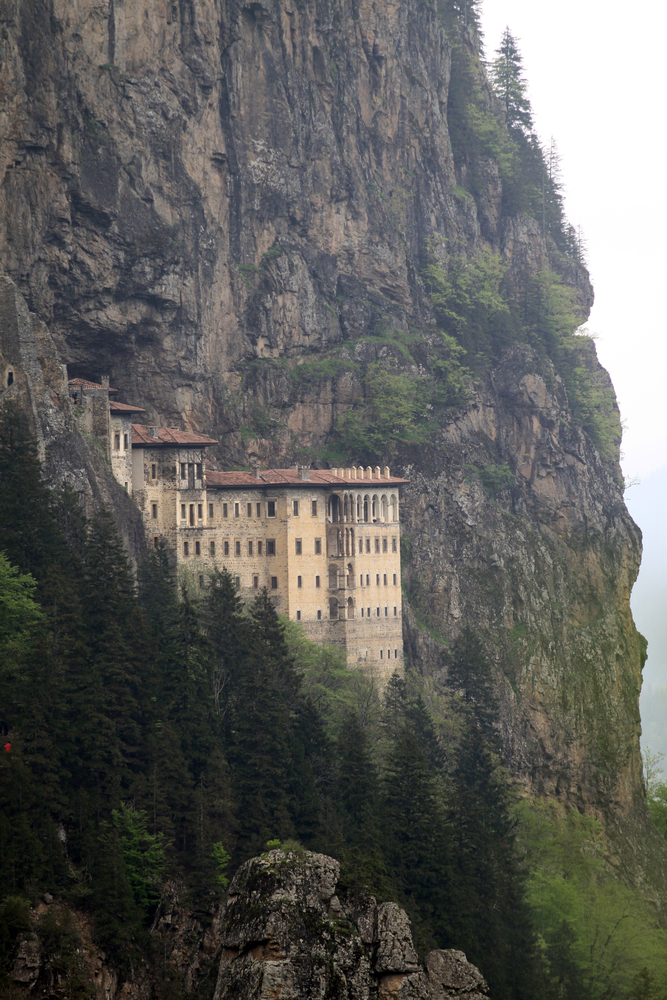
The monastery of Panagia Soumela, so holy to the Greeks and others in the region that visiting it seven times earned a pilgrim the honorific "Hadji" before his name, is today a ruin and a destination for tourists. It perches at an altitude of about 1.2 kilometers on the ledge partway up the face of a steep cliff in the Altındere valley, in the Macka region south of Trebizond. Despite--or perhaps because of--the reverence in which it was held, it doesn't appear as a destination or locus in the folktales, although legends did arise around it.
The legend about its founding in AD 386 has it that two priests undertook its creation after discovering a miraculous icon--said to have been written by the evangelist Luke--of the Mother of God, the Virgin Mary, in a nearby mountain cave. The site was abandoned in 1923 during the Greek-Turkish exchange of populations. Since the monks on their departure were forbidden from taking any property with them, they buried their famous icon under the floor of the monastery's St. Barbara chapel, retrieving it secretly in 1930 and removing it to the newly founded Pontic pilgrimage site, Panagia Soumela Monastery on Mount Vermion in Macedonia, Greece.
As of 2012, the Turkish government is funding restoration work, and the monastery is enjoying a revival in pilgrimage from Greece and Russia. The first Orthodox liturgy since the Exchange was celebrated there on August 15, 2010.
I've borrowed this image from Pontian. info, as it is one of the best I've found for identifying the various elements of dress, some of which are mentioned by name in the folktales. Headgear and firearms are mentioned most often by name.
For anyone who wants a better understanding of Pontic men's costume, check out this page: http://www.pontian.info/costumes/costumemen.htm.
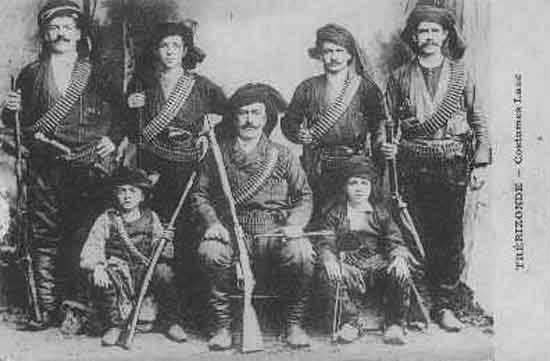
A group of men wearing the traditional costume associated with Pontic Greek guerrilla fighters.
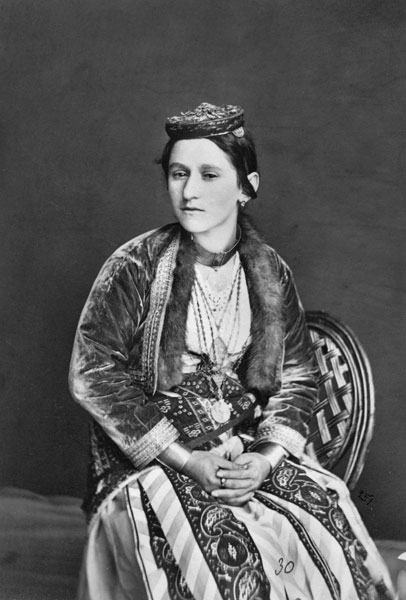
A Pontic Greek woman in traditional costume. Pontic society was organized along strictly patriarchal lines. A household usually comprised grandfather and grandmother, their sons and their wives, unmarried daughters, and their sons’ children. The patriarch of the clan was always the oldest male of the house. Pontic society was virilocal (women went to live in their husbands' homes), and the bride was not always chosen from within the village, so she could find herself upon marriage far from her birthplace and among strangers. She would also lose her given name and come to be called by a feminized version of her husband’s name: Maria, once she became the wife of--say--Stoforos, would be renamed Stoforina.
Since one household could comprise many nuclear families, the Pontians developed the tradition of mash’ to help cope with pressures within. Mash’ meant that a bride was not allowed to speak aloud to her father- or mother-in-law, nor to her husband’s older brothers and sisters, nor even to other daughters-in-law who had been there longer than she, though she could communicate through gesture. Often this silence was dropped after the bride had born her first son, but it was not unheard of for a daughter-in-law to live and die in a household without ever having spoken to most of the other members in it. A common attribute of a good folktale bride is that she was so good that “she had a mouth but she didn’t have a voice.”
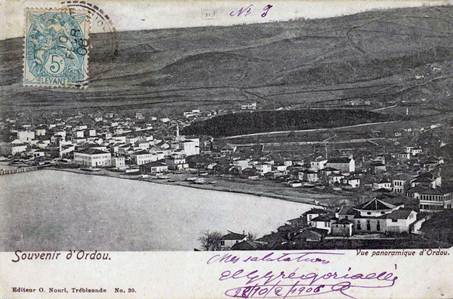
By the 19th century, Kotyora was commonly known by its Turkish name, Ordu. It was used under Mohammed II as a mustering point for troops before the final assault on Trebizond (the name Ordu means “army camp” and came into English as "horde"). It was a natural gathering place. Sailors and merchants appreciated its natural, spacious harbor (visible here), while travelers and caravan-drivers appreciated that it lay on the easternmost route over relatively low mountain passes to the interior. The gently rising country of the hinterland (seen in the background) to the east of the town provided ample rich arable and pastoral land and supported a traditionally transhumant pastoral life. Later, as economic conditions improved, some Kotyorites began to live year-round in the city.
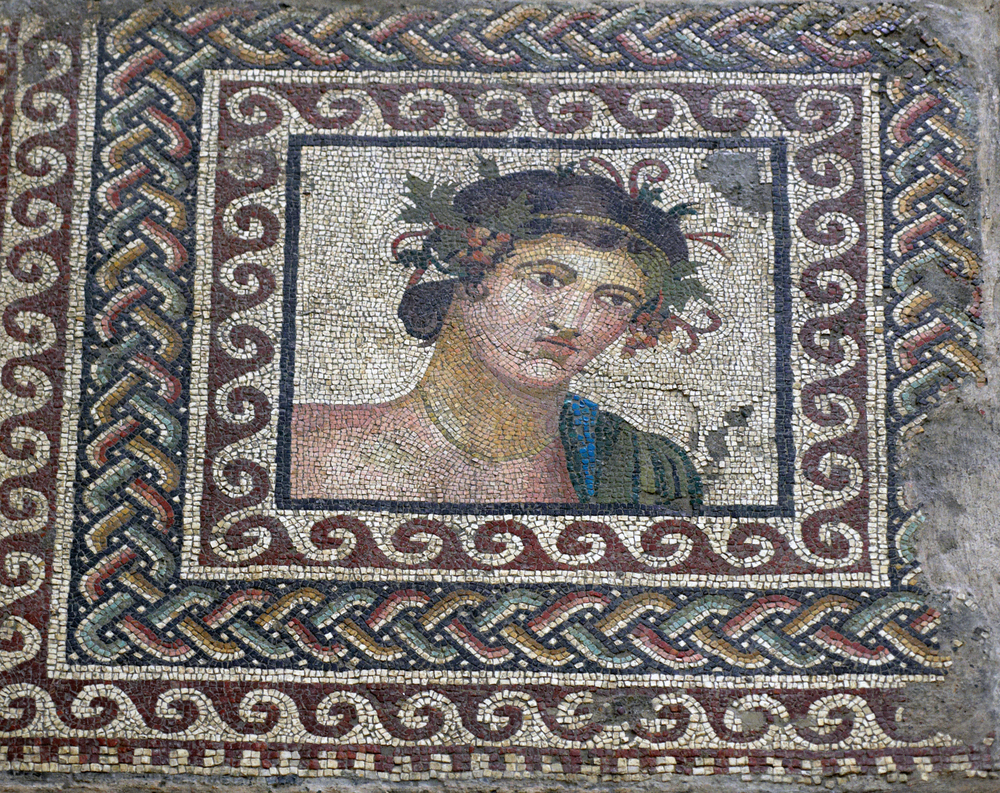
The Black Sea coast has long been a place of human habitation. Amisos, also known in Greek as Samsounta and in Turkish as Samsun, has an archaeological record reaching back to the paleolithic times, when the Tekkekoy Caves were occupied. It became a Greek colony in the 8th century BC, when Greeks from Miletus settled there. Its combination of fertile ground and shallow waters attracted numerous settlers and traders. Far later, it formed part of the kingdom of Pontos, then the empires of Alexaner the Great, the Romans, the Byzantines, and the Seljuks. It was a Genoese outpost for a while, before finally being taken over by the Ottomans in the start of the 15th century.
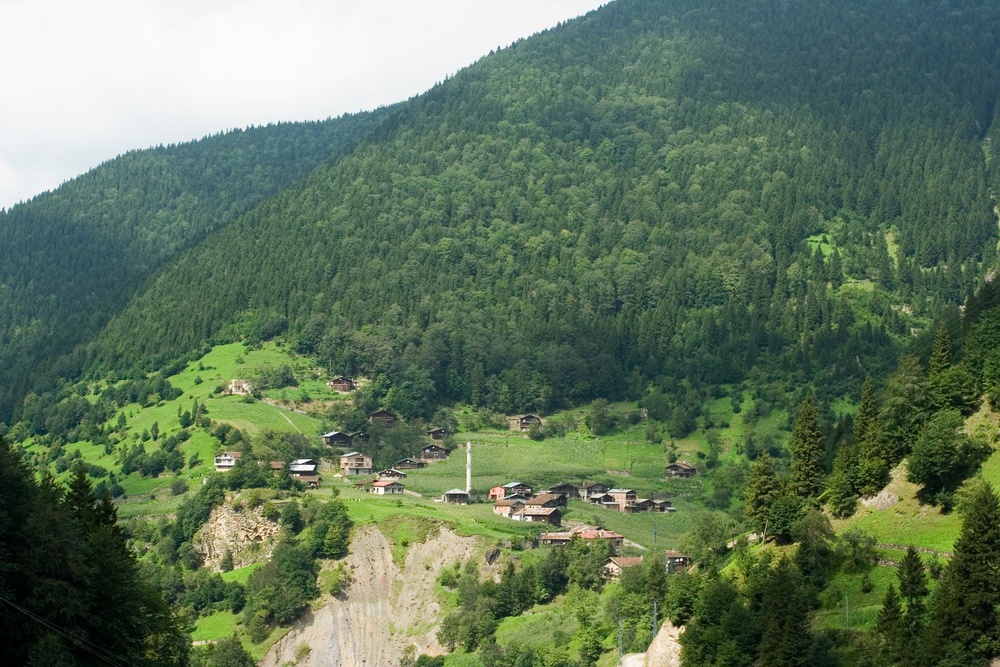
The Pontians are a Hellenic, Orthodox Christian people from the eastern half of the Black Sea coastal region of Asia Minor, known as the Pontos, where they lived until the Greek-Turkish Exchange of Populations of 1923-24. The region is bounded by the river Halys (Kizil-irmak) on the west, Russia on the east, high mountains, sometimes called the Pontic Alps, to the south, and the Black Sea to the north. As members of the Greek-rite Orthodox Church, they were officially registered within the Ottoman Empire as members of the Millet-i Rum. They were differentiated by their religion from the Turks and the other peoples of the Ottoman Empire; they were also set apart by geography from the rest of the Ottoman Greeks. Today the Pontians living in Greece and elsewhere around the world define themselves by their ancestors' place of birth and see themselves and their history as originating within the physical bounds of the Pontos.
Here you see a village tucked away among the Pontic Mountains, looking much as the villages of Santa, Imera, Stavrin, and Kotyora would have looked.
Note that the mountains here, like the mountains of the folktales, are covered by dense forests, predominantly conifer. Within it could be found such wildlife such as the Caucasian Black Grouse, the Ring Ouzel, and the Red-fronted Serin. The Pontus contained the Euxine-Colchic deciduous forests, Anatolia's temperate rain forests.
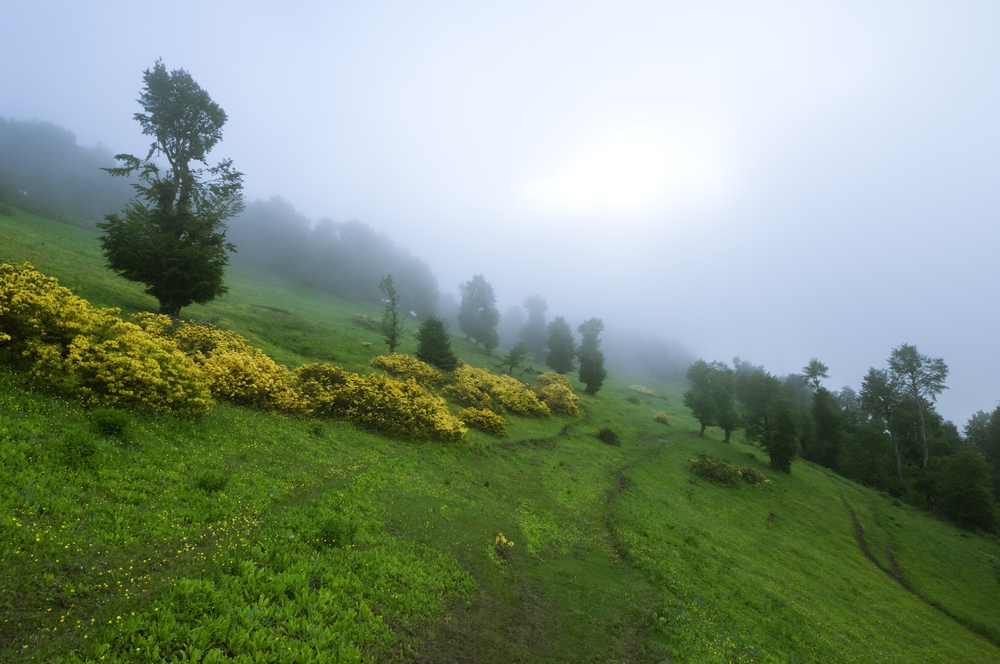
A Pontic mountainside in springtime. Note the touch of fog. In Filon Ktenides's play O Xeniteas (The Exile), Toton declares his allegiance to the homely pleasures of the Pontic slopes: “If I didn’t see our mountains every day, if I didn’t hear the voice of the river, the whistle of the shepherd, the bells of our sheep as soon as I wake in the morning; if I didn’t drink some water from every spring, or if I didn’t stretch out to rest in the shade of the wild apple tree or of the black poplar…by your faith! How could I survive?” (p.35).
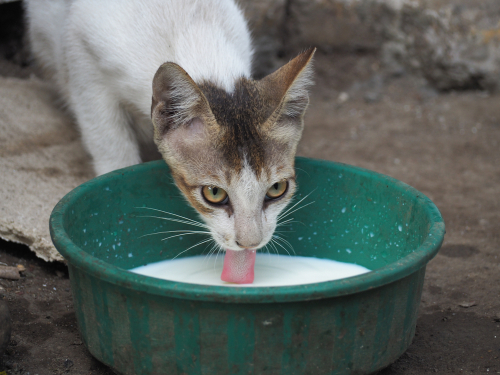
In Kerasounta around 1880, Ioannis Valavanis collected a folktale called, "The Cat and the Fox." It begins, "An old woman put some yogurt to set but her cat ate it on the sly. So the old woman put out some more yogurt to set and hid in the manger to watch. She caught the cat in the act of eating it and hit him, saying, “Scram! Get lost!” The cat fled into the woods yowling and screeching.
Pontic Greek cuisine was an agrarian one based mainly on dairy, especially from cows (see Kochilas 2001, p.4), as opposed to the Helladic Greek dependence on olive oil and sheep's milk. This is an instance where the theft of food sets off the key chain of events.
